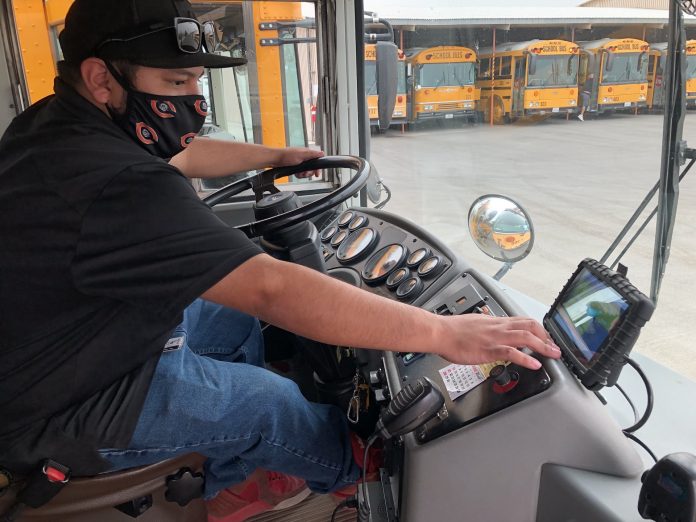Long before the COVID-19 pandemic began, school bus drivers at Dubuque Community Schools in Iowa were able to check into their Tyler Drive tablets. They identified their bus, signed in, and received route information, student information and other live data directly before they set out for their morning and afternoon runs.
“They can do their pre-trip inspection on the tablets, they pick out the buses and the routes that they’re driving that day,” explained Transportation Manager Ernie Bolibaugh, as he sat in the driver’s seat of a school bus with a mounted tablet nearby during a video interview with the local Telegraph Herald last October. “They install [the tablets] on the bus. From there, they’ll pick out the route and start running the route. The students scan as they come on the bus, or drivers can manually load the students [names] on the bus, at each stop along the way.”
Then came COVID-19. Parents as well as teachers were concerned about reopening. During Dubuque’s July 20 school board meeting, high school teacher Haley Lammer-Heindel spoke in support of a return-to-school hybrid model. Others wanted to return to all in-person teaching.
By early August, the district moved its start date back by 10 days to Aug. 24 with an A/B hybrid model selected, wherein groups of students attend physical class on certain days while others remain at home in virtual learning. This model enables 78 percent of the district’s students to go back to school in person, KCRG reported.
Such an environment can use all the available help and any technology tools that can expedite the daunting task of reopening schools. Tablets are one such tool that may be able to assist, if not right away, whenever student transportation regains its full momentum.
Still, tablet acceptance has yet to take off nationwide. The initial hardware cost and ongoing monthly data chargers are the biggest culprits. Only 15 percent of over 200 magazine readers said this summer that they currently use tablets on the school buses. But another survey for last month’s Bus Technology Summit indicated nearly 30 percent of over 800 readers said they forecast purchasing tablets over the coming year.
With COVID-19 processes in place, tablets may be an especially useful tool for drivers to use as a checklist before and after each trip, a means of accounting for which students are on the bus, and aid for contact tracing in the event a student or transportation staff contract the virus. In fact, the latter already happened by Sept. 2, just nine days into the new school year, when Dubuque reported its first student COVID-19 case, media reports confirmed.
“Our Tyler Drive solution increases the functionality of traditional student ridership,” said Ted Thien, vice president and general manager of the Tyler Technologies transportation solutions group. “For example, if a student boards the bus and they are getting on the wrong vehicle or off at the wrong stop, Tyler Drive will notify the driver. This is a game-changer for substitute drivers. They are more comfortable knowing they have Tyler Drive to help them, just like the dispatcher was riding next to them. If a student forgets their ridership card, for example, they can still be accounted for on Tyler Drive. This has proven to be very valuable as we help districts ramp up for contact tracing on buses.”
Staying Prepared with Tablets
Thien added that Tyler Drive keeps the integrity of the bus stop. “What this means is if a driver skips a stop and needs help getting back to a stop,” he shared. “The Tyler Drive unit will direct them to the safest way, not necessarily the quickest way, and maintain the integrity of right side only if this is a requirement on how the bus approaches. This is a critical feature for K-12 transportation.”
Unlike Dubuque, many schools are virtual for now— not hybrid and not in-person at all. In anticipation of bus transportation eventually returning, those who invested in tablets are upbeat about their usefulness in the future. The data that driver tablets gather will be useful to build confidence, in an era of COVID-19, where awareness and control is prioritized.
“Our tablets are able to do directions, but our focus on tablets will be using the app so students and parents know where the bus is and when it will be arriving at stops, or when the bus arrives at the school after athletic trips, field trips, academic events trips, or after school,” explained Katie Delano, director of transportation services at Coalinga-Huron Unified School District, located in central California. The area is known for its agriculture, oil, cannabis and prisons. “Students will scan their ID’s so we know when they are on and off. We have a tremendous number of rural stops as we cover four counties in our runs, so it will be helpful for when we return to transporting students. Right now, we are 100-percent online learning, and no meal runs currently. Students were supplied with internet hotspots so bus Wi-Fi is not needed.”
Port Arthur Independent School District (ISD) in Texas. initially delayed its opening to Aug. 31, due to COVID-19 concerns. Then came Hurricane Laura, which hit the county hard, knocking out power to much of the area, including school facilities. Though the tablets, computers and other devices are internet-ready, Transportation Director Esther Chapman noted that a lack of power interrupts their use for virtual learning. Thus, the district again pushed back reopen- ing to Sept. 8.
Similar to Coalinga-Huron Unified School District, Port Arthur ISD purchased the tablets for use by drivers but have yet to use them, as the district continues with all-virtual classes. While the district was utilizing buses to deliver meals to students prior to the hurricane, it plans to put the tablets to use when students return to in-person learning.
School bus drivers have the option of using their own mobile devices as opposed to using district-owned tablets that must be checked out daily, but most operations STN spoke to are not going that route.
“We take them off [the bus each day],” said Chapman. “The drivers have to sign a form. As they come in and get their keys, they get their tablets. They turn them in every trip, and we put them on a charger. … And we keep them locked because we don’t want anybody breaking in the bus and taking the equipment.”
Despite Functionality, Adoption Is Slow
Integrating technology into school transportation operations is often sluggish. Simply purchasing technology and getting it ready for use can be challenging enough because of budget constraints. But there’s a newfound urgency, given the pandemic prevalence.
Because tablets have multiple uses—navigation, engine diagnostics, safety checklists, accountability—new uses may come about that help improve the safety and health of students now and in the future. That doesn’t mean that paper checklists for accountability are a thing of the past.
Related: Pennsylvania School Bus Driver Navigates New Technology, Shares Challenges of the Job
Related: (STN Podcast E30) Bus Tech Takes Off: Using Technology for Safety & Efficiency During COVID-19
Related: Cleaning, Screening and Accountability
Unlike using tablets for checklists, Delano said Coalinga-Huron still maintains a paper trail. “We have paper [cleaning checklists] forms for this and will continue using paper service checks [for safety and bus readiness measures],” she added. “We will compare if the two should be on the same page, then move toward all electronic, when [the California Highway Patrol] agrees.”
“We gave [tablets] a run at the end of last year, just a trial run, with those helping to implement it,” said Port Arthur’s Chapman. “But we haven’t actually had the opportunity to use live kids [for tracking]. We got the drivers familiar with it, how to log in, how to do pre-trip and do their inspection, and all their [engine] di- agnostics. We got them to be able to go in [and read data used in routing directions], how to go left, and right on their route. But we haven’t had the opportunity to actually do the student loading and student counts.”
The tablets have many different functions that can and will be used, now and into the future. Those who have it, are finding benefits even before COVID-19. As more pupils return to school, the tablets’ usefulness will likely grow in popularity as a tool for districts to manage fleets and student transportation in challenging times.
“At this point, due to COVID, it’s hard to say,” concluded Chapman. “It works well. Due to COVID-19, we’re not using it with students right now. But we do know that it works. It’s user-friendly and drivers have no problem with it.”
Editor’s Note: As reprinted from the October issue of School Transportation News.

















